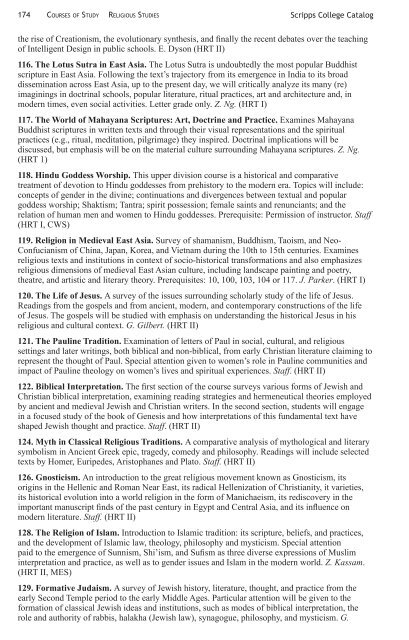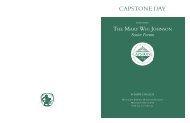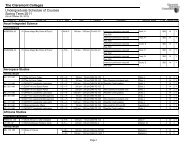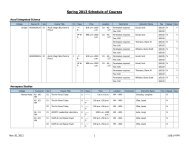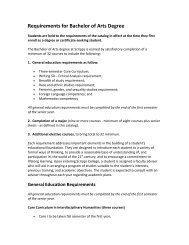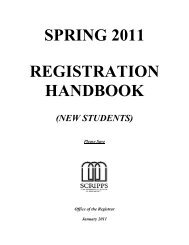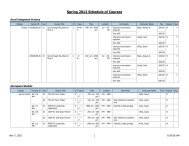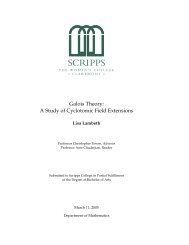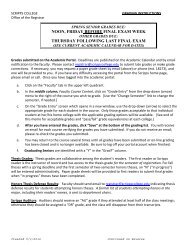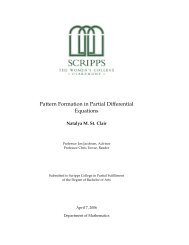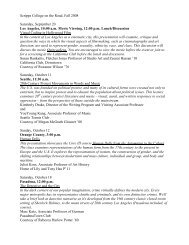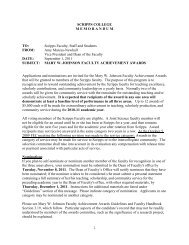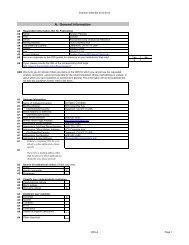PDF of the 2012-2013 Academic Catalog - Scripps College
PDF of the 2012-2013 Academic Catalog - Scripps College
PDF of the 2012-2013 Academic Catalog - Scripps College
You also want an ePaper? Increase the reach of your titles
YUMPU automatically turns print PDFs into web optimized ePapers that Google loves.
174 Courses <strong>of</strong> Study Religious Studies <strong>Scripps</strong> <strong>College</strong> <strong>Catalog</strong><br />
<strong>the</strong> rise <strong>of</strong> Creationism, <strong>the</strong> evolutionary syn<strong>the</strong>sis, and finally <strong>the</strong> recent debates over <strong>the</strong> teaching<br />
<strong>of</strong> Intelligent Design in public schools. E. Dyson (HRT II)<br />
116. The Lotus Sutra in East Asia. The Lotus Sutra is undoubtedly <strong>the</strong> most popular Buddhist<br />
scripture in East Asia. Following <strong>the</strong> text’s trajectory from its emergence in India to its broad<br />
dissemination across East Asia, up to <strong>the</strong> present day, we will critically analyze its many (re)<br />
imaginings in doctrinal schools, popular literature, ritual practices, art and architecture and, in<br />
modern times, even social activities. Letter grade only. Z. Ng. (HRT I)<br />
117. The World <strong>of</strong> Mahayana Scriptures: Art, Doctrine and Practice. Examines Mahayana<br />
Buddhist scriptures in written texts and through <strong>the</strong>ir visual representations and <strong>the</strong> spiritual<br />
practices (e.g., ritual, meditation, pilgrimage) <strong>the</strong>y inspired. Doctrinal implications will be<br />
discussed, but emphasis will be on <strong>the</strong> material culture surrounding Mahayana scriptures. Z. Ng.<br />
(HRT 1)<br />
118. Hindu Goddess Worship. This upper division course is a historical and comparative<br />
treatment <strong>of</strong> devotion to Hindu goddesses from prehistory to <strong>the</strong> modern era. Topics will include:<br />
concepts <strong>of</strong> gender in <strong>the</strong> divine; continuations and divergences between textual and popular<br />
goddess worship; Shaktism; Tantra; spirit possession; female saints and renunciants; and <strong>the</strong><br />
relation <strong>of</strong> human men and women to Hindu goddesses. Prerequisite: Permission <strong>of</strong> instructor. Staff<br />
(HRT I, CWS)<br />
119. Religion in Medieval East Asia. Survey <strong>of</strong> shamanism, Buddhism, Taoism, and Neo-<br />
Confucianism <strong>of</strong> China, Japan, Korea, and Vietnam during <strong>the</strong> 10th to 15th centuries. Examines<br />
religious texts and institutions in context <strong>of</strong> socio-historical transformations and also emphasizes<br />
religious dimensions <strong>of</strong> medieval East Asian culture, including landscape painting and poetry,<br />
<strong>the</strong>atre, and artistic and literary <strong>the</strong>ory. Prerequisites: 10, 100, 103, 104 or 117. J. Parker. (HRT I)<br />
120. The Life <strong>of</strong> Jesus. A survey <strong>of</strong> <strong>the</strong> issues surrounding scholarly study <strong>of</strong> <strong>the</strong> life <strong>of</strong> Jesus.<br />
Readings from <strong>the</strong> gospels and from ancient, modern, and contemporary constructions <strong>of</strong> <strong>the</strong> life<br />
<strong>of</strong> Jesus. The gospels will be studied with emphasis on understanding <strong>the</strong> historical Jesus in his<br />
religious and cultural context. G. Gilbert. (HRT II)<br />
121. The Pauline Tradition. Examination <strong>of</strong> letters <strong>of</strong> Paul in social, cultural, and religious<br />
settings and later writings, both biblical and non-biblical, from early Christian literature claiming to<br />
represent <strong>the</strong> thought <strong>of</strong> Paul. Special attention given to women’s role in Pauline communities and<br />
impact <strong>of</strong> Pauline <strong>the</strong>ology on women’s lives and spiritual experiences. Staff. (HRT II)<br />
122. Biblical Interpretation. The first section <strong>of</strong> <strong>the</strong> course surveys various forms <strong>of</strong> Jewish and<br />
Christian biblical interpretation, examining reading strategies and hermeneutical <strong>the</strong>ories employed<br />
by ancient and medieval Jewish and Christian writers. In <strong>the</strong> second section, students will engage<br />
in a focused study <strong>of</strong> <strong>the</strong> book <strong>of</strong> Genesis and how interpretations <strong>of</strong> this fundamental text have<br />
shaped Jewish thought and practice. Staff. (HRT II)<br />
124. Myth in Classical Religious Traditions. A comparative analysis <strong>of</strong> mythological and literary<br />
symbolism in Ancient Greek epic, tragedy, comedy and philosophy. Readings will include selected<br />
texts by Homer, Euripedes, Aristophanes and Plato. Staff. (HRT II)<br />
126. Gnosticism. An introduction to <strong>the</strong> great religious movement known as Gnosticism, its<br />
origins in <strong>the</strong> Hellenic and Roman Near East, its radical Hellenization <strong>of</strong> Christianity, it varieties,<br />
its historical evolution into a world religion in <strong>the</strong> form <strong>of</strong> Manichaeism, its rediscovery in <strong>the</strong><br />
important manuscript finds <strong>of</strong> <strong>the</strong> past century in Egypt and Central Asia, and its influence on<br />
modern literature. Staff. (HRT II)<br />
128. The Religion <strong>of</strong> Islam. Introduction to Islamic tradition: its scripture, beliefs, and practices,<br />
and <strong>the</strong> development <strong>of</strong> Islamic law, <strong>the</strong>ology, philosophy and mysticism. Special attention<br />
paid to <strong>the</strong> emergence <strong>of</strong> Sunnism, Shi’ism, and Sufism as three diverse expressions <strong>of</strong> Muslim<br />
interpretation and practice, as well as to gender issues and Islam in <strong>the</strong> modern world. Z. Kassam.<br />
(HRT II, MES)<br />
129. Formative Judaism. A survey <strong>of</strong> Jewish history, literature, thought, and practice from <strong>the</strong><br />
early Second Temple period to <strong>the</strong> early Middle Ages. Particular attention will be given to <strong>the</strong><br />
formation <strong>of</strong> classical Jewish ideas and institutions, such as modes <strong>of</strong> biblical interpretation, <strong>the</strong><br />
role and authority <strong>of</strong> rabbis, halakha (Jewish law), synagogue, philosophy, and mysticism. G.


